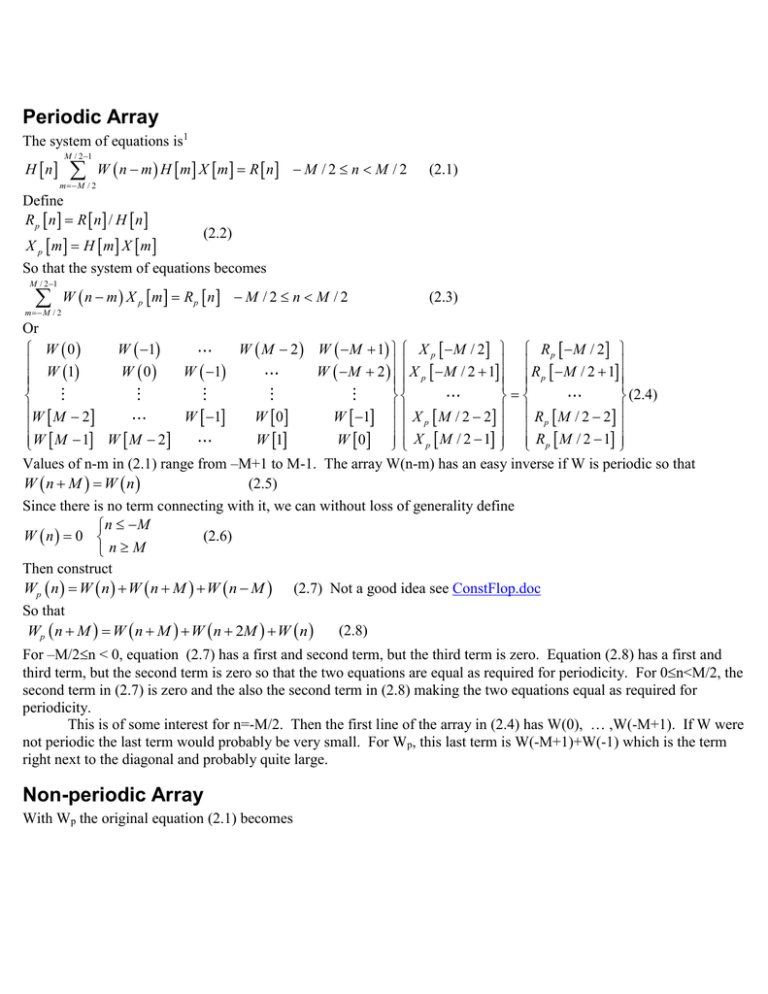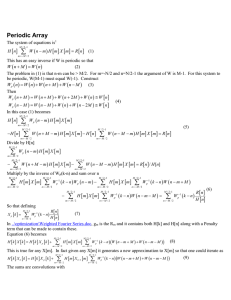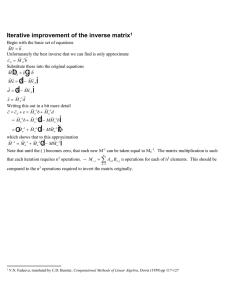advertisement

Periodic Array The system of equations is1 H n M / 2 1 m M / 2 W n m H m X m R n M / 2 n M / 2 (2.1) Define Rp n R n / H n (2.2) X p m H m X m So that the system of equations becomes M / 2 1 m M / 2 W n m X p m Rp n M / 2 n M / 2 (2.3) Or W 1 W M 2 W M 1 X p M / 2 R p M / 2 W 0 W 0 W 1 W M 2 X p M / 2 1 R p M / 2 1 W 1 (2.4) W M 2 X M / 2 2 R M / 2 2 W 1 W 0 W 1 p p W 1 W 0 X p M / 2 1 R p M / 2 1 W M 1 W M 2 Values of n-m in (2.1) range from –M+1 to M-1. The array W(n-m) has an easy inverse if W is periodic so that (2.5) W n M W n Since there is no term connecting with it, we can without loss of generality define n M W n 0 (2.6) nM Then construct Wp n W n W n M W n M (2.7) Not a good idea see ConstFlop.doc So that (2.8) Wp n M W n M W n 2M W n For –M/2n < 0, equation (2.7) has a first and second term, but the third term is zero. Equation (2.8) has a first and third term, but the second term is zero so that the two equations are equal as required for periodicity. For 0n<M/2, the second term in (2.7) is zero and the also the second term in (2.8) making the two equations equal as required for periodicity. This is of some interest for n=-M/2. Then the first line of the array in (2.4) has W(0), … ,W(-M+1). If W were not periodic the last term would probably be very small. For Wp, this last term is W(-M+1)+W(-1) which is the term right next to the diagonal and probably quite large. Non-periodic Array With Wp the original equation (2.1) becomes H n M / 2 1 m M / 2 H n Wp n m H m X m M / 2 1 m M / 2 W n M m H m X m H n M / 2 1 m M / 2 (3.1) W n M m H m X m R n Divide by H[n] M / 2 1 m M / 2 Wp n m H m X m M / 2 1 m M / 2 W n M m H m X m M / 2 1 m M / 2 W n M m H m X m R n / H [n ] Multiply by the inverse of Wp(k-n) and sum over n M / 2 1 m M / 2 H m X m M / 2 1 n M / 2 W p1 k n W p n m M / 2 1 m M / 2 So that defining X p k M / 2 1 n M / 2 Wp1 k n R n M / 2 1 m M / 2 H m X m H m X m M / 2 1 W n M / 2 1 p M / 2 1 n M / 2 W p1 k n W n m M M / 2 1 k n W n m M n M / 2 W 1 p k n R n (3.2) H n (3.3) H n Equation (3.2) becomes H k X k H k X p k M / 2 1 m M / 2 H m X m M / 2 1 n M / 2 W p1 k n W n m M W n m M (3.4) This is true for any X[m]. In fact given any X[m] it generates a new approximation to X[m] so that one could iterate as H k X it k H k X p k M / 2 1 m M / 2 H m X it 1 m M / 2 1 n M / 2 W p1 k n W n m M W n m M (3.5) The sums are convolutions with ws ti M / 2 1 W m M W m M exp j 2 f t m i m M / 2 ti Ti m ; fm (3.6) M T And hxit 1 ti M / 2 1 m M / 2 H m X it 1 m exp j 2 f m ti ti Ti m ; fm M T (3.7) Note that time is defined in terms of T/M, not T/N. 1 M / 21 T H m X it 1 m W n m M W n m M T m M / 2 M (3.8) Then with wp1 ti M / 2 1 m M / 2 W p1 m exp j 2 f m ti 1 M / 21 1 T Wp k n HWs X it 1 n T n M / 2 M i M / 2 hxit 1 ti ws ti exp j 2 f m ti HWs X it 1 f m (3.9) M / 2 1 M / 2 1 i M / 2 hws xit 1 ti wp1 ti exp j 2 f k ti (3.10) The FFT’s in (3.6) and (3.9) need to be made once for every new choice of M. The FFT’s in (3.7) and (3.10) need to be made for every iteration. Since this starts from (3.1) which is merely a restating of (2.1), and X[m] can be used as the first iteration. Finally (3.11) H k X it k H k X p k HWs X it 1Wp1 k Diagonal Array Define W hat to be all but the diagonal terms of W W n Wd 0 Wˆ n With Wd the original equation (2.1) becomes H n M / 2 1 m M / 2 Wd 0 m,n H m X m H n M / 2 1 m M / 2 W n m H m X m R n (4.1) Multiply by the inverse of Wd(k-n) and sum over n M / 2 1 n M / 2 H n Wd1 k ,n M / 2 1 m M / 2 Wd 0 m,n H m X m M / 2 1 n M / 2 H n Wd1 k ,n M / 2 1 m M / 2 W n m H m X m M / 2 1 n M / 2 Wd1 k ,n R n (4.2) So that H k H k X k H k Wd1 M / 2 1 m M / 2 W k m H m X m Wd1 R k (4.3) So that as an iterative method H k X it k Wd1 R k / H k Wd1 M / 2 1 m M / 2 W k m H m X it 1 m (4.4) This is true for any X[m]. In fact given any X[m] it generates a new approximation to X[m] so that one could iterate as The sums are convolutions with M / 2 1 Ti m wˆ ti Wˆ m exp j 2 f m ti ti ; fm (4.5) M T m M / 2 And M / 2 1 Ti m hxit 1 ti H m X it 1 m exp j 2 f m ti ti ; fm (4.6) M T m M / 2 Note that ti is defined in terms of T/M, not T/N. ˆ H k X it k Wd1 R k / H k Wd1 WHX it 1 k (4.7) Error in the solution The set of equations (2.1) arises from minimizing 2. The R[n] is the derivatives of 2 with respect to the n’th coefficient. In a first order expansion 2 02 M / 2 1 D n M / 2 n Dn ,0 R n (5.1) Assume that the error in the final steps is dominated by the error in solving for Dn-Dn.0 rather than from truncation of the expansion in (5.1). After solving for X n = Dn-Dn,o H n M / 2 1 m M / 2 W n m H m X m R n n (5.2) So that after the final step 2 02 M /2 n M / 2 m n Mixing Equations (3.11) and (4.7) generate new solutions from old. In addition there are tridiagonal and band methods for truncating W to a few bands in (2.4) to generate solutions, but no inverse. It makes sense to combine all of these with a set of adjustable coefficients to give the best fit. One extra twist, the periodic solutions should be best in the middle, thus include it with apexp(-(4fm/MT)2) so that it is weighted towards the middle of the integration region. Find a1 to ak by minimizing 2 err M / 2 1 n M / 2 n a n a (6.1) K W n m H m ak X k m R n n a (6.2) m M / 2 k 1 Each sum over M is a convolution 1 M / 21 T M / 21 W n m H m X m k w ti hx ti exp j 2 f n ti (6.3) T m M / 2 N i M / 2 So that H n M / 2 1 K T H n ak W HX k n R n n a (6.4) k 1 Then 2 M / 2 1 err n a n a c.c. (6.5) ak ' n M / 2 ak ' And 2 M / 2 1 2 err n a n a c.c. (6.6) ak ' ak '' n M / 2 ak ' ak '' There are K2 terms in (6.6). The equation to solve is 2 2 K 2 err err a (6.7) k ak k '1 ak ' ak ' The matrix is symmetric and positive definite so Cholesky matrix inversion is appropriate. For very large arrays M 103-6, so that K ~ 102 is appropriate. In practice this allows us to start with Xp, Xtridiagonal, and Xshort band. These are solved using 7 for the best starting array, which is then used in (3.11) to generate a new X which can be added to the mixture. 1 This system equations usually occurs as part of Newton Raphson iteration. In this case the R is the set of residuals which is constantly getting smaller. These interact a bit to the approximation of X below causing one set to want a band like solution and the next set to want a periodic solution. Also since R is in principly going to zero, highly accurate solutions at each step are not needed.





